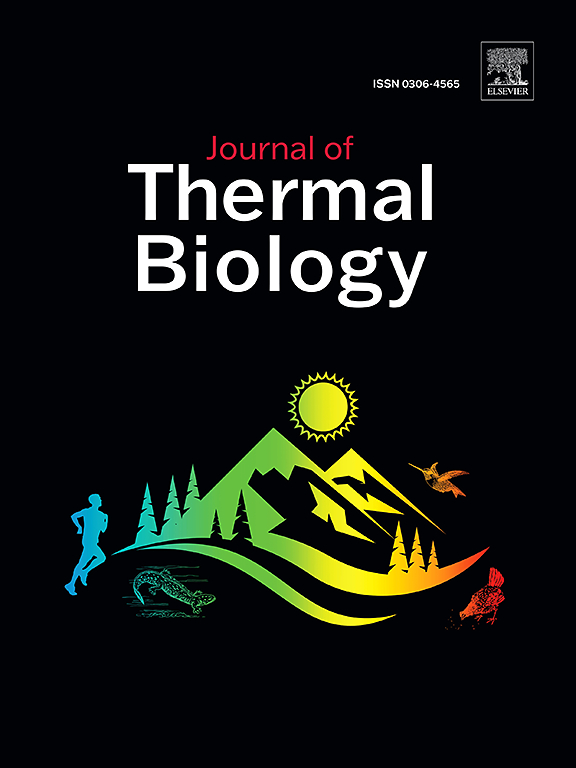Increased offspring size and reduced gestation length in an ectothermic vertebrate under a worst-case climate change scenario
IF 2.9
2区 生物学
Q2 BIOLOGY
引用次数: 0
Abstract
As global temperatures continue to rise, understanding the impacts of warming environments has become increasingly important. Temperature is especially relevant for ectothermic organisms which depend upon consistent and predictable annual temperature cycles for reproduction and development. However, additional research is required in this area to elucidate the potential impacts of climate change on future generations. To understand how projected increases in environmental temperatures may impact reproductive outcomes within natural populations of ectothermic vertebrates, we manipulated minimum ambient temperatures during gestation in Red-sided garter snakes (Thamnophis sirtalis parietalis). Wild snakes were collected in the Interlake region of Manitoba, Canada during their spring mating season and allowed to mate in controlled conditions. For the duration of gestation, mated females were placed into one of two ambient thermal conditions: temperatures emulating those found in the species’ natural habitat or temperatures with a consistent 5 °C increase to match end-of-century climate change projections. We recorded observations for each litter and all neonates resulting from controlled mating trials. We observed no difference in litter sizes or birth rates between thermal conditions. However, we observed a significant reduction in gestation length and significant increase to neonate body mass and body condition associated with increased ambient temperatures. These results suggest that increased minimum temperatures during gestation may confer reproductive benefits for the northern populations of this species even under the most extreme current modeled warming predictions. We discuss the broader implications of this effect, including possible negative ecological outcomes.
在最坏的气候变化情况下,外温脊椎动物的后代体型增大,妊娠期缩短。
随着全球气温持续上升,了解环境变暖的影响变得越来越重要。温度对体外温度生物尤其重要,因为它们的繁殖和发育依赖于稳定和可预测的年度温度周期。然而,要阐明气候变化对后代的潜在影响,还需要在这一领域开展更多的研究。为了了解预计的环境温度升高会如何影响外温脊椎动物自然种群的繁殖结果,我们对红边吊带蛇(Thamnophis sirtalis parietalis)妊娠期间的最低环境温度进行了控制。在春季交配季节,我们在加拿大马尼托巴省的湖间地区采集了野生蛇,并让它们在受控条件下交配。在妊娠期间,交配后的雌蛇被置于两种环境温度条件中的一种:仿照该物种自然栖息地的温度或根据本世纪末气候变化预测持续升高5 °C的温度。我们对控制交配试验产生的每一窝雏鸟和所有新生儿进行了观察记录。我们观察到,不同温度条件下的产仔数和出生率没有差异。但是,我们观察到,随着环境温度的升高,妊娠期明显缩短,新生儿的体重和身体状况明显增加。这些结果表明,即使在目前最极端的气候变暖模型预测下,妊娠期最低气温的升高也可能会给该物种的北方种群带来繁殖益处。我们讨论了这种效应的广泛影响,包括可能的负面生态结果。
本文章由计算机程序翻译,如有差异,请以英文原文为准。
求助全文
约1分钟内获得全文
求助全文
来源期刊

Journal of thermal biology
生物-动物学
CiteScore
5.30
自引率
7.40%
发文量
196
审稿时长
14.5 weeks
期刊介绍:
The Journal of Thermal Biology publishes articles that advance our knowledge on the ways and mechanisms through which temperature affects man and animals. This includes studies of their responses to these effects and on the ecological consequences. Directly relevant to this theme are:
• The mechanisms of thermal limitation, heat and cold injury, and the resistance of organisms to extremes of temperature
• The mechanisms involved in acclimation, acclimatization and evolutionary adaptation to temperature
• Mechanisms underlying the patterns of hibernation, torpor, dormancy, aestivation and diapause
• Effects of temperature on reproduction and development, growth, ageing and life-span
• Studies on modelling heat transfer between organisms and their environment
• The contributions of temperature to effects of climate change on animal species and man
• Studies of conservation biology and physiology related to temperature
• Behavioural and physiological regulation of body temperature including its pathophysiology and fever
• Medical applications of hypo- and hyperthermia
Article types:
• Original articles
• Review articles
 求助内容:
求助内容: 应助结果提醒方式:
应助结果提醒方式:


